Defibrillators for schools
Every day, countless pupils, students, and teachers occupy school classrooms, auditoriums, school playgrounds, libraries, and sports halls across Ireland. A sudden cardiac arrest can occur at any time and place, making it crucial to have immediate access to a defibrillator. By initiating CPR and employing a defibrillator, the chances of survival significantly increase, even before the arrival of an ambulance.
-
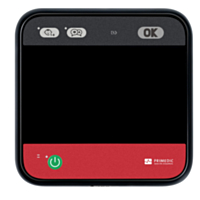 + Free wall CabinetPrimedic Heartsave myPAD Defibrillator Fully AutomaticManufacturer : PrimedicSemi or full automatic : Fully AutomaticQuality label : MDRThe Primedic Heartsave myPAD Semi-Automatic is a compact, easy-to-use defibrillator that gives clear voice instructions during CPR. It’s designed for both adults and children and is built to perform well in tough environments.
+ Free wall CabinetPrimedic Heartsave myPAD Defibrillator Fully AutomaticManufacturer : PrimedicSemi or full automatic : Fully AutomaticQuality label : MDRThe Primedic Heartsave myPAD Semi-Automatic is a compact, easy-to-use defibrillator that gives clear voice instructions during CPR. It’s designed for both adults and children and is built to perform well in tough environments. -
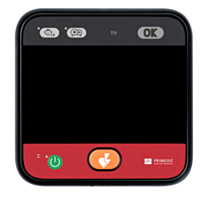 + Free wall CabinetPrimedic Heartsave myPAD Defibrillator Semi-automaticManufacturer : PrimedicSemi or full automatic : Semi AutomaticQuality label : MDRWith its extensive features, the Primedic Heartsave myPAD Semi-automatic provides optimal support during CPR. Thanks to its voice instructions, IP66 rating, and child button, this defibrillator is a reliable choice.
+ Free wall CabinetPrimedic Heartsave myPAD Defibrillator Semi-automaticManufacturer : PrimedicSemi or full automatic : Semi AutomaticQuality label : MDRWith its extensive features, the Primedic Heartsave myPAD Semi-automatic provides optimal support during CPR. Thanks to its voice instructions, IP66 rating, and child button, this defibrillator is a reliable choice. -
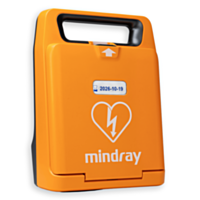 + Free wall CabinetMindray BeneHeart C1A V2 Defibrillator Fully-AutomaticManufacturer : MindraySemi or full automatic : Fully AutomaticQuality label : CEThe Mindray BeneHeart C1A V2 is ideal for both experienced rescuers and the general public. Thanks to the new LCD screen, instructions are now even clearer. In addition, the new audio alarm ensures that fault signaling is even more noticeable.
+ Free wall CabinetMindray BeneHeart C1A V2 Defibrillator Fully-AutomaticManufacturer : MindraySemi or full automatic : Fully AutomaticQuality label : CEThe Mindray BeneHeart C1A V2 is ideal for both experienced rescuers and the general public. Thanks to the new LCD screen, instructions are now even clearer. In addition, the new audio alarm ensures that fault signaling is even more noticeable. -
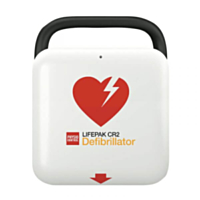 + Free wall CabinetPhysio-Control Lifepak CR2 USB Defibrillator Fully-AutomaticManufacturer : Physio ControlSemi or full automatic : Fully AutomaticQuality label : CE, FDAThe Physio Control Lifepak CR2 - USB includes very clear instructions and is suitable for almost every environment due to the high IP rating.
+ Free wall CabinetPhysio-Control Lifepak CR2 USB Defibrillator Fully-AutomaticManufacturer : Physio ControlSemi or full automatic : Fully AutomaticQuality label : CE, FDAThe Physio Control Lifepak CR2 - USB includes very clear instructions and is suitable for almost every environment due to the high IP rating. -
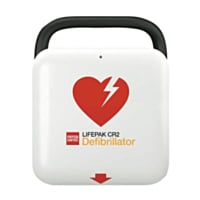 + Free wall CabinetPhysio-Control Lifepak CR2 USB Defibrillator Semi-AutomaticManufacturer : Physio ControlSemi or full automatic : Semi AutomaticQuality label : CE, FDAThe Physio Control Lifepak CR2 - USB includes very clear instructions. This makes it extremely user-friendly for both trained and untrained users. In addition, the Lifepak CR2 - USB has a high IP rating and is therefore suitable for placement in virtually any environment.
+ Free wall CabinetPhysio-Control Lifepak CR2 USB Defibrillator Semi-AutomaticManufacturer : Physio ControlSemi or full automatic : Semi AutomaticQuality label : CE, FDAThe Physio Control Lifepak CR2 - USB includes very clear instructions. This makes it extremely user-friendly for both trained and untrained users. In addition, the Lifepak CR2 - USB has a high IP rating and is therefore suitable for placement in virtually any environment. -
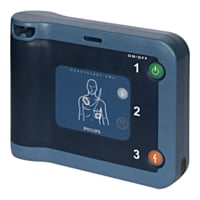 + Free wall CabinetPhilips Heartstart FRx DefibrillatorManufacturer : PhilipsSemi or full automatic : Semi AutomaticQuality label : CE, FDAEasy to use High IP55 resistance against dust and water contamination 8 year manufacturer warranty SMART Biphasic Technology to issue a gentler shock to the heart SMART ECG Analysis Technology Self-Test function ensures the defibrillator is always rescue ready Optional child/infant key to enable use on both adults and children with one set of electrodes See full description below for more information, specifications and details of our service and maintenance contracts.
+ Free wall CabinetPhilips Heartstart FRx DefibrillatorManufacturer : PhilipsSemi or full automatic : Semi AutomaticQuality label : CE, FDAEasy to use High IP55 resistance against dust and water contamination 8 year manufacturer warranty SMART Biphasic Technology to issue a gentler shock to the heart SMART ECG Analysis Technology Self-Test function ensures the defibrillator is always rescue ready Optional child/infant key to enable use on both adults and children with one set of electrodes See full description below for more information, specifications and details of our service and maintenance contracts.
Contact us for advice or a better offer -
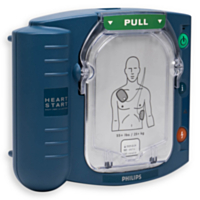 + Free wall CabinetPhilips Heartstart HS1 DefibrillatorManufacturer : PhilipsSemi or full automatic : Semi AutomaticQuality label : CE, FDAEasy to use Gives both AED ancd CPR guidance 8-year manufacturer warranty SMART Biphasic Technology to issue a gentler shock to the heart SMART ECG Analysis Technology Self-Test function ensures the defibrillator is always rescue ready See full description below for more information, specifications and details of our service and maintenance contracts. Contact us for advice or a better offer.£845.00 £1,014.00In stock, available immediately
+ Free wall CabinetPhilips Heartstart HS1 DefibrillatorManufacturer : PhilipsSemi or full automatic : Semi AutomaticQuality label : CE, FDAEasy to use Gives both AED ancd CPR guidance 8-year manufacturer warranty SMART Biphasic Technology to issue a gentler shock to the heart SMART ECG Analysis Technology Self-Test function ensures the defibrillator is always rescue ready See full description below for more information, specifications and details of our service and maintenance contracts. Contact us for advice or a better offer.£845.00 £1,014.00In stock, available immediately -
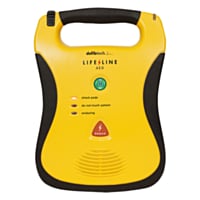 + Free wall CabinetDefibtech Lifeline Defibrillator Semi-AutomaticManufacturer : DefibtechSemi or full automatic : Semi AutomaticQuality label : CE, FDAThe Defibtech Lifeline is one of the most popular semi-automatic defibrillators due to it’s robust design and clear, easy to use operation. A clear, calm voice prompts the user through every step of the resuscitation process, stating each instruction clearly and concisely, one step at a time. The bright lights provide clear visual guidance to reinforce voice instructions. Simple, clear and straightforward, with only two buttons on the unit, one to turn the unit on and one to shock the patient if necessary. This AED has a very long 7 year battery and adult pads included. Please click here for the fully-automatic version.£965.00 £1,158.00In stock, available immediately
+ Free wall CabinetDefibtech Lifeline Defibrillator Semi-AutomaticManufacturer : DefibtechSemi or full automatic : Semi AutomaticQuality label : CE, FDAThe Defibtech Lifeline is one of the most popular semi-automatic defibrillators due to it’s robust design and clear, easy to use operation. A clear, calm voice prompts the user through every step of the resuscitation process, stating each instruction clearly and concisely, one step at a time. The bright lights provide clear visual guidance to reinforce voice instructions. Simple, clear and straightforward, with only two buttons on the unit, one to turn the unit on and one to shock the patient if necessary. This AED has a very long 7 year battery and adult pads included. Please click here for the fully-automatic version.£965.00 £1,158.00In stock, available immediately -
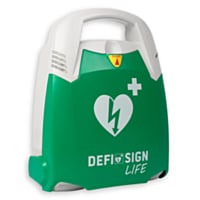 + Free wall CabinetDefiSign LIFE Defibrillator Fully-AutomaticManufacturer : SchillerSemi or full automatic : Fully AutomaticQuality label : CEThe DefiSign LIFE AED fully automatic is easy to operate thanks to clear spoken instructions and visual support. This defibrillator is multilingual and has high dust and water resistance.£858.00 £1,029.60In stock, available immediately
+ Free wall CabinetDefiSign LIFE Defibrillator Fully-AutomaticManufacturer : SchillerSemi or full automatic : Fully AutomaticQuality label : CEThe DefiSign LIFE AED fully automatic is easy to operate thanks to clear spoken instructions and visual support. This defibrillator is multilingual and has high dust and water resistance.£858.00 £1,029.60In stock, available immediately -
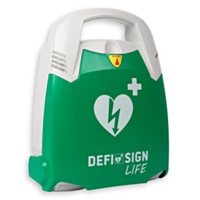 + Free wall CabinetDefiSign LIFE Defibrillator Semi-AutomaticManufacturer : SchillerSemi or full automatic : Semi AutomaticQuality label : CEThe DefiSign LIFE AED semi-automatic is easy to operate thanks to clear spoken instructions and visual support. This multilingual defibrillator is water and dust resistant (IP55).£858.00 £1,029.60In stock, available immediately
+ Free wall CabinetDefiSign LIFE Defibrillator Semi-AutomaticManufacturer : SchillerSemi or full automatic : Semi AutomaticQuality label : CEThe DefiSign LIFE AED semi-automatic is easy to operate thanks to clear spoken instructions and visual support. This multilingual defibrillator is water and dust resistant (IP55).£858.00 £1,029.60In stock, available immediately -
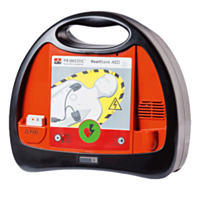 + Free wall CabinetPrimedic Heartsave AED DefibrillatorManufacturer : PrimedicSemi or full automatic : Semi AutomaticQuality label : CE, TüVThe Primedic AED is equiped with a convenient button enabling the defibrillator to switch between child and adult mode, meaning that separate child electrodes are not required.
+ Free wall CabinetPrimedic Heartsave AED DefibrillatorManufacturer : PrimedicSemi or full automatic : Semi AutomaticQuality label : CE, TüVThe Primedic AED is equiped with a convenient button enabling the defibrillator to switch between child and adult mode, meaning that separate child electrodes are not required.
The Primedic HeartSave AED automatically turns on when the cover is opened. The HeartSave comes configured in the Dutch, English, German and French languages as standard, but it is possible to upload alternative languages if required.
Defibrillators for schools in the UK - The best devices with child mode
To cater to the needs of schools, a defibrillator must fulfil several criteria. These involve ease of operation for individuals of all ages, providing real-time CPR guidance, and the ability to switch to paediatric mode using child electrodes. Certain defibrillators feature a convenient child button, eliminating the need for separate electrodes. Below are our best defibrillators for schools and universities.
Frequently asked questions about defibrillators for schools:
Why defibrillators in schools?
Sudden cardiac arrest (SCA) can strike anyone, at any age – including students, teachers, and visitors. When every second counts, having a defibrillator (AED) on-site can make a huge difference. Immediate defibrillation significantly increases the chances of survival, especially when delivered within the first few minutes.
Schools are busy, active environments where fast response is critical. By installing a defibrillator and training staff in its use, schools become safer places for everyone. Defibrillators are simple to use, even for non-medical personnel, and modern devices give clear voice prompts to guide users through every step.
Equipping your school with a defibrillator shows a strong commitment to safety, preparedness, and the wellbeing of your community.
Where should a school defibrillator be located?
In a school setting, a defibrillator (AED) should be located in a central, easily accessible area where it can be reached quickly in an emergency — ideally within 1–2 minutes. Common locations include the main reception area, staff room, or a central hallway. It’s essential that the AED is clearly visible, mounted on the wall, and marked with appropriate signage.
For larger schools or campuses, additional defibrillators may be necessary near high-risk areas such as sports halls, playgrounds, or remote classrooms. Outdoor defibrillator cabinets can also be considered for after-school access during community events or sports activities.
Quick access saves lives — make sure staff and pupils know where the AED is and how to respond in an emergency.
Do I need separate child electrodes?
Paediatric patients (<8 years or <25kg) need less shock energy than adults. Paediatric electrodes deliver a lower energy shock. The school defibrillator must be capable of treating both adult and paediatric patients. In most cases, this requires two sets of electrodes: one for adults and another for paediatric patients. However, electrodes have a limited shelf life and need replacement, which over time, can become costly.
We, therefore, advise primary schools to choose a defibrillator with child mode. You use the adult electrodes and switch to the paediatric protocol with the push of a button. No need for separate paediatric electrodes! The biggest advantage is that you don't need to switch electrodes, saving precious time. Examples of defibrillators with child mode are the Mindray BeneHeart C1A and the CU Medical i-pad SP1 defibrillators.
Also, check out our page on using an AED with child electrodes or a child button.
Should I choose a semi-automatic or fully automatic defibrillator for my school?
The choice depends on the user. Try to think about who will use the defibrillator in an emergency. Is this a first aid officer or, for example, a teacher who has done a CPR course? Then go for a semi-automatic. Is it unknown who the user will be, or will it mainly be inexperienced rescuers? Then opt for a fully automatic machine. Read more about the differences between fully and semi-automatic defibrillators.
Did you know that CPR training in schools is mandatory throughout the UK? Also have a look at our selection of training manikins and accessories.